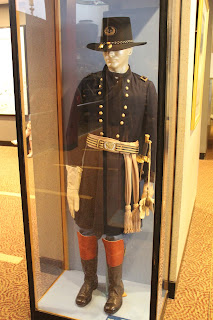After three weeks of travelling in the US, Belgium and France I am finally back home. I naturally used this opportunity to visit a number of battlefields, military museums and other military sites in these countries. I was particularly interested in getting a sense for the "lay of the land" in these places in order to get a better understanding of the operational manoeuvres and battles.
The first place I visited was Atlanta, Georgia, where several interconnected battles were fought during the summer of 1864. Without going into too much detail, in this battle Sherman's Federal army attacked Johnston's well entrenched Confederates on a broad front. The aim of the Federal army was to break through this position and push on to capture the railway and logistics hub of Atlanta some 30 km away.
As can be seen from the pictures below, the terrain consists of woods interspersed by fields. Mostly the woods are pretty "open", although in places visibility can be quite limited due to undergrowth. At the time the forests would have been even more open as cattle was allowed to graze in the woods and trees would be cut for firewood.
The terrain was also quite hilly. The Kennesaw ridge was quite imposing but even the smaller hills must have made command and control and movements somewhat difficult. Another factor was the heat. When I visited the site the temperature was around 30 degrees Celsius, with humidity being quite high. I walked some distance cross-country and there was definitely the risk of becoming exhausted or dehydrated in these conditions. Thunderstorms and heavy rain showers took place on other days of my visit, which would have made the going even more tough.
 |
| Dense vegetation |
 |
| Open woods |
 |
| The area was interspersed by fields and clearings |
 |
| Federal gun emplacements - 4 batteries were placed here to bombard Kennesaw mountain |
 |
| 12 pdr Napoleon situated in front of Kennesaw mountain |
 |
| Treeline |
 |
| Rocky terrain dominated Pigeon Hill |
 |
| Confederate fieldworks at Pigeon Hill |
 |
| Pigeon Hill now (viewed from South East) |
 |
| Pigeon Hill then (viewed from the East) with Federal trenches in the forefront |
 |
| Confederate 3" rifled artillery dug in at Cheatham Hill |
At Cheatham Hill Confederate batteries were divided and pairs of cannon were deployed in "concealed" redoubts. These positions, concealed by forest, would provide a nasty surprise for Federal infantry advancing through the dense woods.
 |
| 12" Napoleon guns in a concealed redoubt |
The most severe fighting took place at what became known as the "Dead Angle" at Cheatham Hill. The Federals attempted to assault this position frontally only to suffer severe casualties and become pinned down at the base of Confederate earthworks (which was the only cover available).
 |
| Confederate trenches at the "Dead Angle" |
 |
| Artist's impression of the fighting at the "Dead Angle" |
 |
| The Illinois monument: erected to honour the brave Federal soldiers that were cut down assaulting the Dead Angle |
As a testament to the severity (an relative recentness of the fighting), the Dead Angle still contained a number of trees from the time of the battle, whose tops were misformed and riddled with bullets.
Atlanta Cyclorama
I also got the chance to visit the Atlanta Cyclorama, which is a truly remarkable piece of work. It presents a panorama view of the battle of Atlanta with further immersion provided by a large number of mannequins and other replica making it seem like you are in the middle of the battle. The massive painting (13m tall and 109m wide) was painted already in the 19th century with Civil War veterans originally acting as curators! The present curator was pretty good also but I particularly enjoyed the audiotaped narration of the course of the battle by James Earl Jones.
























No comments:
Post a Comment